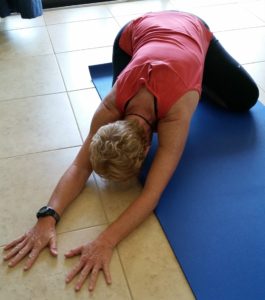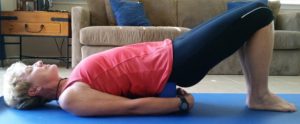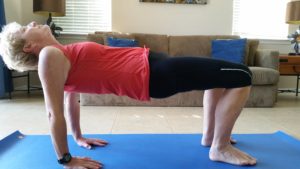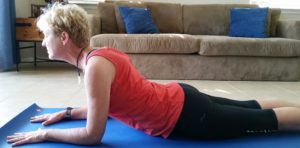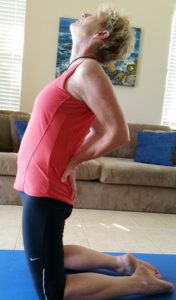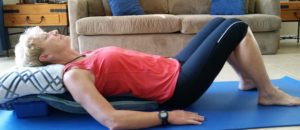Yoga for asthma relief
by Nancy B. Loughlin
Published in News Press on April 11, 2017
For about 25 million American asthmatics, the breath can be the enemy.
According to Dr. Charles V. Klucka, an allergy and asthma specialist based in SW Florida, asthma is a chronic, obstructive airway disease.
An asthma attack’s possible triggers are plentiful and vary significantly from individual to individual. The cause can be allergic (i.e., cat or dust allergies) or non-allergic due to viral infections or, for some people, exercise.
Traditional treatments include medications, allergy injections, and avoidance of common triggers. But even these measures won’t eliminate attacks completely.
Asthma attacks are frightening. Peggy Phillips, life-long asthma sufferer in SW Florida, described how harrowing an attack can be: “It’s as if someone is tightening a belt around my chest. It keeps getting tighter and tighter, and that, of course, elicits fear and makes the attack worse. To say that I’m gasping is inadequate. I become simply desperate for breath. Desperate is the word.”
“I have to slow down and remind myself that the anxiety and terror aren’t real, and they will just exacerbate the attack. My mind has to take over,” she said.
This is yoga.
Relief is available. Yoga, with its stretching, relaxation and deep breathing exercises, is an excellent, non-pharmacologic way of preventing severe attacks, Dr. Klucka said.
Check with your doctor, and check out the asthma flow.
The Thirty-Minute Flow
- Mountain Pose.
Dr. Klucka explained the straight posture of Mountain Pose decreases the inspiratory effort required to get air deep in the lungs.
Stand with your big toes touching with your feet parallel or your heels an inch apart. Allow a natural sway in your lower back and retract your ribs so your heart is directly above your hips. Lift and separate your collarbone, and drive your shoulder blades down your back. Your head should be over your heart.
Close your eyes and focus on maintaining your posture and smooth breath for three minutes.
In one study involving 57 adults over a 30-week period, teaching good posture and twice-daily breathing exercises decreased the need for rescue inhalers during attacks significantly as well as allowed for less use of daily inhaled steroids,” Dr. Klucka said.
Pranayama
Reducing stress is key for decreasing attacks’ severity and frequency. Focusing on the breath is a basic meditation technique to activate the parasympathetic nervous system.
- Alternate-Nostril breathing. Move to the floor, and sit comfortably either cross-legged or on your knees so your back is straight. Pinch the left side of your nose and inhale through the right. Hold the nose and the breath for four counts then release the breath only through the left nostril. Inhale left. Release right. Continue for eight rounds or until you feel serene.
- Bellows Breath. Place both hands on your abdomen and close your eyes. As you inhale, expand the belly like a balloon for four counts. Then release the breath for six counts, pulling the belly to the spine. Continue for eight rounds.
“Belly” or diaphragmatic breathing as opposed to shallow thoracic breathing ensures more air gets deeper into the lungs where oxygen is exchanged with the blood stream, Dr. Klucka said.
But, for shallow chest breathers, learning to belly breathe can be a challenge. As you practice, place a block or rice bag on your abdomen. As you inhale, focus on using your core muscles to lift the block or bag to the ceiling.
Strengthen the upper body with the breath.
- Two-Part Breath in Plank. This breath will begin to stretch the intercostal muscles between the ribs to open the chest cavity.
Move to a push-up position or to plank. You can be on your toes or knees.
Take one long, deep inhale to inflate the belly. When the belly is at capacity, continue the inhalation to expand the chest. Feel the side body and ribs stretch. At the last moments of the inhalation, feel your collarbone spread and lift. Pause for a moment before you completely empty the body of breath through the mouth, and prolong the exhalation for as long as you can. Continue for eight rounds.
Open the Chest
- Child’s Pose with side stretch. Drop to your knees, sit back on your heels and stretch your arms forward on the mat. With your forehead on the floor, walk your hands to the right to stretch the side body. Hold, and then switch sides.
- Supported Bridge to Full Bridge. Return to your seat, and lie back. Bend your legs so the soles of your feet are on the floor, parallel, and about six inches away from the buttocks.
On the inhale, engage your feet and legs and push your hips to the ceiling. Your shoulders stay grounded to the floor. Until you build the strength to hold for three minutes, slide a block under your tailbone for supported Bridge.
- Reverse Tabletop to Reverse Plank. Sit on the floor with your legs bent and soles of the feet on the floor. Push your hands into the floor just behind your hips, fingers facing forward. On the inhale, lift your hips to the ceiling and support yourself with your arms and legs as if you were a table. Keep your neck neutral and hold.
When you build more upper body strength, straighten your legs and point your toes for Upward Plank.
- Sphinx to Cobra. Flip onto your belly. Place your palms on the floor under your shoulders, and press your forearms into the floor. As you lift your head and chest off the floor, keep your neck neutral and imagine that you are pulling your hips along the floor toward your elbows.
When you’re ready, move into Cobra by straightening your arms. Be sure to open your collarbone and drop your shoulders away from your ears. Push your heart forward, and be open.
- Modified Camel to Full Camel. The final pose is optional, and you should only do it when you are flexible and warm.
Come to your knees, and curl your toes under. Place the palms of your hands on your low back just above the buttocks. Squeeze your elbows toward each other, and be sure your fingertips are pointing down. Push your hips forward and keep them directly over your knees. When your heart is open, drop your head back. When you are ready, move into full Camel. Reach behind you, and grab your heels. Keep your hips over your knees, and open the front body completely.
Savasana
- Supported Corpse Pose. Lie on the floor with a block or bolster between your shoulder blades. Allow your head to hang back and your heart to push through your shoulders.
Relax and heal.
Resources: Dr. Charles V. Klucka, D.O., P.A., specializes in allergy and asthma. He has offices in both Fort Myers and Port Charlotte, Florida. Visit his website at www.drklucka.com.

